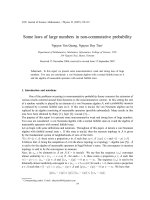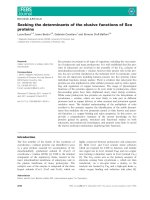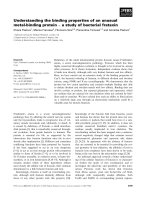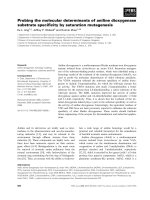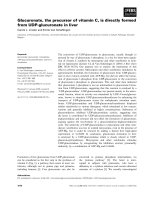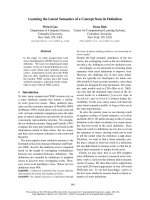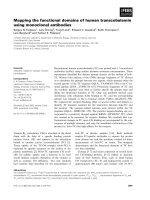Báo cáo " Assessing effects of the waterholding bioproduct Lipomycin M on the amount of effective water in the soil " ppt
Bạn đang xem bản rút gọn của tài liệu. Xem và tải ngay bản đầy đủ của tài liệu tại đây (167.21 KB, 5 trang )
VNU Journal of Science, Earth Sciences 24 (2008) 52-56
52
Assessing effects of the waterholding bioproduct
Lipomycin M on the amount of effective water in the soil
Le Van Thien*, Nguyen Kieu Bang Tam
College of Science, VNU
Received 06 January 2008; received in revised form 14 April 2008
Abstract. Biological solution using strain Lipomyces starkeyi 7.1, which can produce viscous
membranes to improve dry soil is considered to be sustainable for slope land improvement. The
results of research on Lipomycin M ability to keep effective water in the soil of Me Linh District,
Vinh Phuc Province show that in the soil samples cultivated traditional medicinal trees, the total
amounts of effective water in the soil fertilized Lipomycin M (taken out under pressure pF 2.5-4.2)
are always higher than that in control soil plot (without Lipomycin M): the amounts of effective
water in CT2 account for 24.8%, CT3 - 25.1% in comparison with DC (control plot) - 17.1%.
Combination of Lipomycin M with NPK and microbial fertilizers makes the amount of effective
water in the soil higher than that in the case of using only Lipomycin M. Similarly, the amounts of
effective water in the soil samples cultivated tea and manured the bioproduct Lipomycin M are
higher than those for the soil sample DC and proportional to the times of manuring the bioproduct:
TN3 - 29%, TN1 - 24.8%, and DC - 22.2%.
Keywords: Waterholding; Bioproduct; Lipomycin M; Effective water; pF.
1. Introduction
*
Water is vital for plants. Plants cannot
grow without water. Water accounts for 70-
80% of the plant weight. Today, demand for
water in life and industry dramatically
increases, thus causing fresh water scarcity,
surface water pollution and the risk of
inability to provide water for life and
production. So, it is necessary to find
solutions to improve dry soil, uncovered soil
and bare hill, and to reduce the amount of
_______
* Corresponding author. Tel.: 84-4-916027871
E-mail:
water used in production. Biological
methods, including applying microorganisms
to improve dry soil are considered to be
feasible for sustainable production. It can be
seen that soil microorganisms are vital for
improving soil. They are environmentally
effective and friendly solutions because they
do not cause a decline in the soil
microorganisms and help to enhance the soil
biodiversity.
Water holding bioproduct Lipomycin M is
produced by scientists of Institute of
Biological Technology (Vietnam Academy of
Science and Technology) from yeast of
Lipomyces starkeyi 7.1 which has ability to
Le Van Thien, Nguyen Kieu Bang Tam / VNU Journal of Science, Earth Sciences 24 (2008) 52-56
53
produce viscous membranes improve several
physical, chemical and biological
characteristics of slope soil in Me Linh
District (Vinh Phuc Province), such as
increasing ability of holding water, water
capacity and maximum hydroscopic,
reducing soil bulk density, and improving
pH, organic chemicals, macro nutrients, [2,
3, 4]. Besides these, Lipomycin M is
biologically highly safe [4]. Based on findings
about ability to improve soil humidity, it is
necessary to assess the effects of Lipomycin M
on the amount of effective water because only
the effective water is used by plants. This
paper concentrates on assessing the ability of
holding effective water (available for plant) of
the bioproduct Lipomycin M.
2. Materials and methods
2.1. Materials
Studying objects: the holding water
bioproduct Lipomycin M produced by the
Institute of Biological Technology from yeast
of Lipomyces PT 7.1 and the basic compound
cassava starch; garden soil cultivated
traditional medicinal plants and tea owned
by to the station of biodiversity located in Me
Linh District, Vinh Phuc Province; fertilizers:
multi-functional microbiofertilizer and
fertilizer NPK.
2.2. Study method
The experiment was carried out on the
garden soil cultivated traditional medicine
plants (an area of 500m
2
) and cultivated green
tea (approximately 1 ha) with terrain slope of
about 20
0
(Table 1).
Table 1. Formula and dosage of the bioproduct in
experimental samples
Sample Formula Dosage (g/tree)
Plot cultivated traditional medicinal plants
Control
(DC)
Basic compound
cassava starch
10
Variant 1
(CT1)
Bioproduct
Lipomycin M
Lipomycin M: 10
Variant 2
(CT2)
Bioproduct
Lipomycin M +
multi-functional
biofertilizer
Biofertilizer: 5
Lipomycin M: 10
Variant 3
(CT3)
Bioproduct
Lipomycin M +
fertilizer NPK
NPK: 10
Lipomycin M: 10
Plot cultivated tea
Control
(DC)
Basic compound
massava starch
10
Variant 1
(TN1)
Lipomycin M once 10
Variant 2
(TN2)
Lipomycin M twice 10 (at 2-months
interval)
Variant 3
(TN3)
Lipomycin M three
times
10 (at 2-months
intervals)
3. Results and discussion
3.1. Effects of Lipomycin M on the amount of
effective water in the soil sample cultivated
traditional medicine trees
After saturating soil to reach the moisture
of 100% and take out water from saturated
soil samples using different pressures, we can
determine the rates of water types existing in
soil, including: gravity water (to pF: 2.5),
effective water (available for plants: pF: 2.5 –
4.2, and not available for plants: pF > 4.2) [4, 5].
The results presented in Table 2 show that
the total amounts of water taken out under
the pressures to pF=4.2 in the soil samples DC
and CT1 are similar, 35.54g and 36.74g
respectively. This may well reflect that the
water which is stored in soil by the
Le Van Thien, Nguyen Kieu Bang Tam / VNU Journal of Science, Earth Sciences 24 (2008) 52-56
54
bioproduct has a link with soil similar to the
case without the bioproduct. At the same
time, the amounts of water in the soil samples
CT2 and CT3 are higher (38.54g and 39.86g
respectively). This means that fertilizing the
bioproduct Lipomycin M is more efficient
when combining with multi-functional
biofertilizer and synthetic fertilizer NPK.
Table 2. Amounts of water lost under various pressures in
soil samples cultivated traditional medicinal trees (g)
pF 0.6 1.0 1.5 2.0 2.5 2.8 3.0 3.2 3.7 4.2
DC 2.09 4.29 12.54 15.86 18.44 22.05 23.26 24.82 34.92 35.54
CT1 1.04 3.20 12.50 15.14 17.59 21.48 22.70 24.29 34.88 35.74
CT2 1.61 3.84 12.94 16.31 18.97 23.55 25.87 27.22 37.44 38.54
CT3 1.90 3.89 14.23 17.91 19.75 23.54 24.24 25.55 36.56 39.86
Comparison of the percentages of water
stored in the soil samples in various forms
indicates the role of the bioproduct Lipomycin
M in holding water and ability to provide
water for plants (Table 3).
It can be seen from Table 3 that the
percentages of water pushed out from soil
under pressure of 2.5 in the soil experimental
sample CT are lower than that in the soil
sample DC. In the soil sample that is only
fertilized by the bioproduct Lipomycin M, the
amount of water pushed out accounts for
23.5%. In the soil samples CT2 and CT3, these
numbers are 24.0% and 24.6% respectively,
and lower than that of the soil sample DC
(24.8%). It can be suggested from the results
that the bioproduct Lipomycin M can improve
the ability of holding water in soil, thus
reducing the percentage of gravity water in
the soil samples fertilized by the bioproduct.
The total amounts of water stored in the soil
samples manured by the bioproduct are
higher than that of the soil samples without
the bioproduct (DC: 74.17g; CT1: 74,78g; CT2:
79.00g, and CT3: 80.25g). It can be seen the
amount of effective water stored by the
bioproduct in soil samples from the
percentages of water pushed out under the
pressure range from 2.5 to 4.2. The
percentages of effective water pushed out
under the pressure 2.5 – 4.2 in soil samples
manured the bioproduct are higher the soil
sample DC. In the soil samples with a
combination of the bioproduct and multi-
functional biofertilizer and synthetic fertilizer
NPK, the percentages of effective water are
higher than those for the soil samples only
manured the bioproduct. This is because of
more energy and microorganisms are
supplied into soil, thus increasing activity of
the soil microorganisms. In fact, the highest
percentage was recorded for the sample CT3
(25.1%). The next highest samples were CT2
(24.8%) and CT1 (24.4%). The smallest
percentage was recorded for the sample DC,
only accounting for 23.1% of the total amount
of water stored in saturated soil (the
humidity of 100%).
Le Van Thien, Nguyen Kieu Bang Tam / VNU Journal of Science, Earth Sciences 24 (2008) 52-56
55
Table 3. Percentages of water forms in the soil samples cultivated traditional medicinal trees
DC CT1 CT2 CT3
pF
Amount of
water (g)
Percent
(%)
Amount of
water (g)
Percent
(%)
Amount of
water (g)
Percent
(%)
Amount of
water (g)
Percent
(%)
<2.5 18.44 24.8 17.59 23.5 18.97 24.0 19.75 24.6
2.5-4.2 17.10 23.1 18.15 24.4 19.57 24.8 20.11 25.1
4.2 - exhausted
dry
38.63 52.1 39.04 52.1 40.46 51.2 40.39 50.3
Total 74.17 100 74.78 100 79.00 100 80.25 100
Table 4. The amount of water poured under various pressures in soil samples cultivated tea (g)
pF 0.6 1.0 1.5 2.0 2.5 2.8 3.0 3.2 3.7 4.2
DC 1.21 3.25 12.82 14.64 15.89 18.07 18.82 20.31 30.97 32.48
TN1 0.48 3.42 12.36 14.15 15.52 17.42 18.24 20.39 32.69 33.91
TN3 1.41 3.25 9.78 11.72 13.39 17.27 19.35 20.75 33.81 35.67
3.2. Effects of Lipomycin M on the amount of
effective water in soil samples cultivated trees
We carried out the experiment of
manuring the bioproduct on the plot
cultivated tea to get the most reliable results
about the ability to hold effective water of the
bioproduct.
One emerging feature of the soil
cultivated tea different from one cultivated
traditional medicinal trees is that it has higher
slope and the amount of organic compounds
(plentiful plant carcass).
It can be seen from Table 4 that the
amounts of water poured under the pressure
pF ≤ 4.2 in the soil samples manured by the
bioproducts are higher than those of the soil
samples DC. The amount of water poured
from the soil sample TN3 is highest, reaching
35.67g while it is 33.91g for the soil samples
TN1. Both of them are higher than that of the
soil sample DC (32.48g). The results fortify
the claim about the role of the product
Lipomycin M in holding water.
Table 5. Percentages of water forms in the soil samples cultivated tea
DC TN1 TN3
pF
Amount of
water (g)
Percent
(%)
Amount of
water (g)
Percent
(%)
Amount of
water (g)
Percent
(% )
<2.5 15.89 21.4 15.52 21.0 13.39 17.4
2.5-4.2 16.59 22.2 18.39 24.8 22.28 29.0
4.2 - exhausted dry
42.09 56.4 40.35 55.2 41.16 53.6
Total 74.57 100 74.26 100 76.83 100
It can be seen from Table 5 that the
percentages of gravity water in the soil
samples TN are lower than those in the soil
sample DC. This result fortify the role and the
ability of holding water of the bioproduct
Lipomycin M in tea-cultivated soil. A higher
percentages of effective water in soil were
recorded for the soil samples TN; The soil
sample TN3 (manured by the bioproduct
three times at 2-months intervals) has the
highest percentage of effective water (29.0%).
In the soil sample TN1 (manured by the
Le Van Thien, Nguyen Kieu Bang Tam / VNU Journal of Science, Earth Sciences 24 (2008) 52-56
56
bioproduct only once), the effective water
accounted for 24.8% of the total amount of
water. Both were higher than the amount of
effective water in the soil sample DC (22.2%).
It can be suggested from the results that the
bioproduct Lipomycin M enhances the amount
of effective water in soil. However, the
bioproduct need to be manured at 2-months
intervals to get higher efficiency of holding
water and to increase effective water in the soil.
4. Conlusions
1. The holding water bioproduct
Lipomycin M can improve several physical,
chemical and biological characteristics of soil,
especially the ability of holding water.
Meanwhile, water stored in soil has a
relatively high percentage of water available
for plants, thus helping plants growth and
develop faster.
2. In the soil samples cultivated
traditional medicinal trees, the total amount
of water in the soil sample control (DC) is
smallest (74.17g), and lower than that of the
soil sample CT (CT1, CT2 and CT3: 74.78, 79.0,
and 80.28g respectively). Meanwhile, the
percentages of effective water (taken out
under the pF: 2.5 – 4.2) in the soil samples
manured by the bioproduct are higher than
those of the soil sample DC. In fact, in the soil
samples CT2 and CT3, the amounts of
effective water account for 24.8% and 25.1%
respectively, compared with 17.1% for the soil
sample DC. Combination of the bioproduct,
biofertilizer and NPK creates a higher
amount of effective water than that in case of
using only the bioproduct.
3. The amounts of effective water in the
soil samples cultivated tea and manured by
the bioproduct are higher than those for the
soil sample DC and proportional to the time
of manuring the bioproduct. In fact, the
highest percentage of effective water is
recored for the soil sample TN3 with 20.9%.
The next is 24.8% for the soil sample TN1.
The smallest percentage are recorded for the
soil sample control (DC) with 22.2%.
References
[1] M. Aubertin, M. Mbonimpa, M. Bussiere and R.
P. Chapuis, A physically-based model to predict
the water retention curve from basic
geotechnical properties, Canadian Geotechnical
Journal No. 3 (2003) 122.
[2] Nguyen Kieu Bang Tam, Ngo Cao Cuong, Tong
Kim Thuan, Influence of moisture keeping
bioproduct Lipomycin M on some physical
characteristics of slopping soil in Me Linh, Vinh
Phuc, Conference of Basic research issues in Life
Sciences, 2005, 1056-1058 (in Vietnamese).
[3] Nguyen Kieu Bang Tam, Nguyen Thi Hang,
Influence of waterholding bioproduct on some
chemical properties of hill soil in Me Linh, Vinh
Phuc, Soil Science Journal No. 26 (2006) 35 (in
Vietnamese).
[4] Tong Kim Thuan, Nguyen Kieu Bang Tam,
Dang Thi Mai Anh, Ngo Cao Cuong, Applying
the water holding bioproduct to improve hill
soil in Me Linh, Vinh Phuc, Soil Science Journal
No. 23 (2005) 37 (in Vietnamese).
[5] R. Walczak, E. Rovdam and B. Witkowska,
Water retention characteristics of peat and sand
mixtures, International Agrophysics No. 4 (2002)
161.
